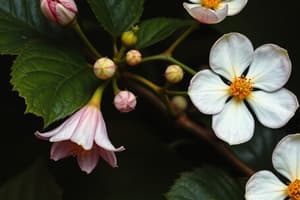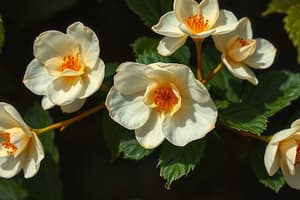Podcast
Questions and Answers
Which of the following describes the function of resin outflow when resin canals are pierced in plants?
Which of the following describes the function of resin outflow when resin canals are pierced in plants?
- Attracting more insects for pollination
- Promoting faster plant growth at the wounded site
- Physically blocking feeding and chemically deterring predation (correct)
- Providing nutrients to the damaged area
Menthol, a monoterpene, is a key component of the essential oil derived from pine trees.
Menthol, a monoterpene, is a key component of the essential oil derived from pine trees.
False (B)
What is the primary role of rubber found in laticifers within plants?
What is the primary role of rubber found in laticifers within plants?
protection
Abietic acid, a diterpene, is commonly found in pines and __________ plants.
Abietic acid, a diterpene, is commonly found in pines and __________ plants.
Match the following terpenes with their example sources:
Match the following terpenes with their example sources:
Which of the following accurately describes the primary role of secondary metabolites in plants?
Which of the following accurately describes the primary role of secondary metabolites in plants?
Primary and secondary metabolites are synthesized through completely distinct and independent metabolic pathways within plants.
Primary and secondary metabolites are synthesized through completely distinct and independent metabolic pathways within plants.
Name two primary metabolic pathways that provide precursors or intermediates for the synthesis of secondary metabolites.
Name two primary metabolic pathways that provide precursors or intermediates for the synthesis of secondary metabolites.
The _________ pathway is responsible for the synthesis of aromatic amino acids, which are precursors to flavonoids and other secondary metabolites.
The _________ pathway is responsible for the synthesis of aromatic amino acids, which are precursors to flavonoids and other secondary metabolites.
Match the following secondary metabolites with their primary precursor pathway:
Match the following secondary metabolites with their primary precursor pathway:
If a plant's Shikimate pathway is blocked, what would be the most immediate consequence?
If a plant's Shikimate pathway is blocked, what would be the most immediate consequence?
Round-Up herbicide works by blocking the Shikimate pathway. What effect does this have on plants?
Round-Up herbicide works by blocking the Shikimate pathway. What effect does this have on plants?
Which statement best describes secondary metabolites?
Which statement best describes secondary metabolites?
Lipids, proteins, nucleic acids, and carbohydrates are considered secondary metabolites.
Lipids, proteins, nucleic acids, and carbohydrates are considered secondary metabolites.
Natural products have only recently been recognized for their ecological roles, such as protecting plants from microbial and insect attacks.
Natural products have only recently been recognized for their ecological roles, such as protecting plants from microbial and insect attacks.
Name four major classes of secondary metabolites found in plants.
Name four major classes of secondary metabolites found in plants.
Terpenes, which are components of essential oils, have a basic structural unit that is a 5-carbon molecule called ______.
Terpenes, which are components of essential oils, have a basic structural unit that is a 5-carbon molecule called ______.
Match the following classes of secondary metabolites with their representative examples:
Match the following classes of secondary metabolites with their representative examples:
What role do terpenoids play in many plants?
What role do terpenoids play in many plants?
All terpenoids are synthesized exclusively from glycolytic intermediates.
All terpenoids are synthesized exclusively from glycolytic intermediates.
What is a distinctive characteristic of all terpenoids when considering their carbon atoms?
What is a distinctive characteristic of all terpenoids when considering their carbon atoms?
Flashcards
Resin Ducts
Resin Ducts
Canals in needles, twigs and trunk of plants that contain resins.
Pinene and Myrcene
Pinene and Myrcene
A class of monoterpenes found in resins of some conifers; some are insecticidal.
Abietic Acid
Abietic Acid
An antiherbivore diterpene acid found in pines and legumes; present in resin canals and deters feeding insects.
Milkweed Glucosides
Milkweed Glucosides
Signup and view all the flashcards
Polyterpenes
Polyterpenes
Signup and view all the flashcards
Metabolism
Metabolism
Signup and view all the flashcards
Primary Metabolites
Primary Metabolites
Signup and view all the flashcards
Secondary Metabolites
Secondary Metabolites
Signup and view all the flashcards
Calvin Cycle
Calvin Cycle
Signup and view all the flashcards
Glycolysis
Glycolysis
Signup and view all the flashcards
Citric Acid Cycle
Citric Acid Cycle
Signup and view all the flashcards
Amino Acid Precursors
Amino Acid Precursors
Signup and view all the flashcards
Shikimate Pathway
Shikimate Pathway
Signup and view all the flashcards
Natural Products
Natural Products
Signup and view all the flashcards
Major Classes of Plant Secondary Metabolites
Major Classes of Plant Secondary Metabolites
Signup and view all the flashcards
Terpenes/Terpenoids
Terpenes/Terpenoids
Signup and view all the flashcards
Terpenoid Synthesis Basic Unit
Terpenoid Synthesis Basic Unit
Signup and view all the flashcards
Function of Terpenoids
Function of Terpenoids
Signup and view all the flashcards
Carbon Atoms in Terpenoids
Carbon Atoms in Terpenoids
Signup and view all the flashcards
Monoterpenes
Monoterpenes
Signup and view all the flashcards
Study Notes
- The sum of all chemical reactions in an organism is metabolism
- Lipids, proteins, nucleic acids, and carbohydrates are primary metabolites
- Most plants divert carbon and energy to synthesize organic molecules without obvious roles in normal cell function
Secondary Metabolites
- Molecules not required for general organism functioning but have specialized functions
- They are highly diverse
- Compounds involved in plant defenses are often toxic secondary metabolites
- Most medicinal and drug compounds are secondary metabolites
Biosynthetic Relationships
- Principal primary and secondary metabolites are circled in a schematic illustration
- Photosynthesis produces sugars from CO2 and H2O
- Sugars undergo respiration, producing acetyl-CoA and amino acids
- Acetyl-CoA is converted into terpenoids/sterols and fatty acids/lipids
- Amino acids are converted into proteins and phenols
- Phenols can also come from Malonyl-CoA
- Sugars are converted into Saponins and Cardiac glycosides
- Amino acids can be turned into alkaloids
- Phenols become Flavonoids, Tannins, and Lignin
- Sugars can be converted into Cyanogenic glycosides or Glucosinolates
Plant Metabolic Pathways
- Products and intermediates from primary metabolism (photosynthesis, respiration) feed into secondary pathways
- The Calvin cycle intermediate product is Erythrose-4-phosphate
- The Glycolysis intermediate product is phosphoenolpyruvate
- The Citric acid cycle intermediate product is Acetyl CoA
- Erythrose-4-phosphate and phosphoenolpyruvate can create a shikimic acid pathway
- Acetyl CoA can create a Malonic Acid Pathway or Mevalonic Acid Pathway
- Aromatic amino acids produce alkaloids
- Phenolic compounds and Terpenes
Amino Acid Biosynthesis
- 20 amino acids are found in proteins.
- 9 essential amino acids exist in humans
- Amino acids are precursors to several secondary compounds
Shikimate Pathway
- Tryptophan is a precursor in the synthesis of auxins (plant hormone)
- Phenylalanine is a precursor in the synthesis of flavonoid pigments
- Herbicide Round-Up blocks their synthesis of metabolites; without these amino acids, plants die
Other key facts on Primary vs Secondary Metabolites
- The distinction can be difficult to make
- Primary and secondary metabolites share several of the same intermediates
- They are derived from the same core metabolic pathways
- Secondary metabolites are not essential for cellular structure or function
- Secondary metabolites generally occur in relatively low quantities
- Production can be widespread or restricted to particular families, genera, or species
- These compounds are also known as natural products
- Natural products have a significant economic and medicinal value
- They are used as folk remedies, soaps, essences, drugs, medicinal products, etc.
- Natural products also have significant ecological functions, like protection against microbial or insect attacks
Major Plant Secondary Metabolic Pathways
- Mevalonic Acid Pathway and MEP (non-mevalonic acid) produces Terpenes
- Shikimic Acid Pathway produces aromatic amino acids
Secondary metabolites can be created by:
- Alkaloids
- Phenolics
Four Major Classes of Secondary Metabolites
- Terpenes: include hormones, pigments, essential oils, steroids, and rubber
- Phenolic compounds: include coumarins, flavonoids, lignin, and tannins
- Glycosides: Include saponins, cardiac glycosides, cyanogenic glycosides, and glucosinolates
- Alkaloids
Terpenes
- Made of Monoterpenes (C10)
- Sesquiterpenes (C15)
- Diterpenes (C20)
- Triterpenes (C30)
- Polyterpenes (C5)n
Phenolic Compounds are made of:
- Coumarin
- Furano-coumarins
- Ligin
- Flavonoids
- Isoflavonoids
- Tanins
Sulphur-containing secondary metabolites are made up of
- GSH
- GSL
- Phytoalexins
- Defensins
- Thionins
- Lectins
Nitrogen-containing secondary metabolites are made up of
- Alkaloids
- Cyanogenic glycosides
- Non-protein amino acids
Terpenes/Terpenoids
- The largest class of secondary metabolites.
- 25,000 have been described
- Some act as primary metabolites for the plant
- They are necessary for cell function for:
- Cell growth modulation
- Light harvesting
- Photoprotection
- Control of membrane fluidity
- They are components of essential oils i.e. the "essences" of plants
- They have numerous applications in medicine
Terpenoid Synthesis
- Accomplished via acetyl CoA via the mevalonic acid pathway
- Acetyl CoA is converted into mevalonic acid
- Terpenoid synthesis is created with different intermediates via the MEP pathway
- This usually occurs in chloroplasts
- Compounds comply with the isoprene rule
- Terpenes build by combining 5 carbon units
- Resulting in structures with 10,15,20,30, or 40 carbons
- The basic unit is 5-Carbon Isoprene
Types of Terpenoids
- Act as toxic and feeding deterrents e.g. Acetyl-coA or glycolytic intermediates
- Composed of a mixture of essential oils includes volatile compounds, limonene, and menthol
- Lends a characteristic odor to their foliage
- Found in glandular hairs that project from the epidermis
- Stored in the modified extracellular space in the cell wall
Linear vs Cyclic Terpenes
- Linear and Cyclic terpenes exist structurally
- Cyclization requires the action of specific enzymes
- non-cyclic terpene, Geraniol exists in Geraniums
- cyclic terpene, Limonene exists in Orange peels
- Both instances of monoterpenes, contain 10 carbons
Hemiterpenes
- iso-Amyl Alcohol exists in Mentha and Eucalyptus
- iso-Valeraldehyde exists in Eucalyptus
Monoterpenes
- They exhibit strong insecticidal responses to insects
- Popular ingredient in commercial insecticides
- Pyrethroids: in the leaves and flowers of chrysanthemum
- Gymnosperms (conifers): pine and fir
- Resin ducts: in the needles, twings, and trunk
- Cucurbitacin: exists in cucurbits
Limonene and Menthol
- Structures of limonene and menthol
- These two well-known monoterpenes protect against insects and other organisms
Pinene, myrcene, and menthol
- They are monoterpenes
- Pinene and myrcene: found in some conifer resin
- Menthol: the principal constituent of the essential oil of peppermint (Mentha piperta)
- Pinene: has demonstrated insecticidal properties
Diterpenes
- Abietic acid is in pines and leguminous plants.
- Diterpenes present in or along with resins in resin canals.
- When these canals are pierced by feeding insects, the outflow of resin may block feeding:
- Providing a chemical deterrent that continues predation.
- Cannabis plants use diterpenes against predators such as insects and animals
Sesquiterpenes
- Sesquiterpenes act as antiherbivore agents, primarily by the compositae family.
- Have a strong feeding repellence that affects many herbivorous insects
Triterpenes
- Milkweeds produce glucosides (sterols)
- Limnoid: in family rutaceae from citrus fruits; act as antiherbivore compounds
- Azadirachtin: complex limnoid from Azadirachta indica; acts as a feeding deterrent to some insects and toxic effects
Terpene Antiherbivore Compounds
- Azadirachtin acts as the active ingredient
- It's a complex limonoid comes from the neem tree (Azadirachta indica)
- Potent feeding deterrent to some insects at doses as low as 50 PPB
- It is an insect control commercial agent w/ low levels of toxicity
Terpene Antiherbivore Compounds: Phytoecdysones
- Phytoecdysones are from common fern
- A group of steroids that have the same basic structure as insect molting hormones
Polyterpenes
- Larger terpenes include the tetraterpenes and the polyterpenes
- Principal tetraterpenes are carotenoids = pigment family
- Rubber: protection mechanism for wound healing and against herbivores
- Rubber is found in long vessels = laticifers
Carotenoids
- Xanthophylls: contains oxygen (Lutein)
- Carotenes: unoxygenated (carbon and hydrogen only) e.g. (α-carotene, β- carotene, lycopene)
Most common type of carotene:
- β-carotene: orange/yellow pigment (carrots & citrus fruits)
- Lycopene: red pigment (peppers & tomatoes0
Monoterpenes and sesquiterpenes:
- Commonly found in glandular hairs on the plant surface
Studying That Suits You
Use AI to generate personalized quizzes and flashcards to suit your learning preferences.




